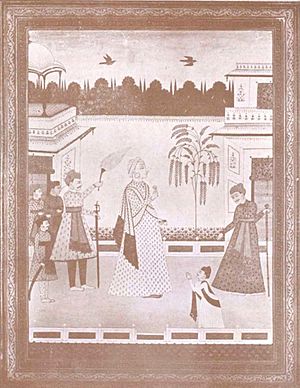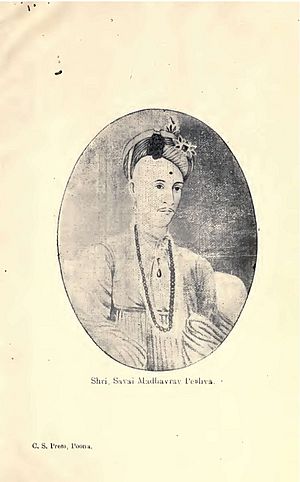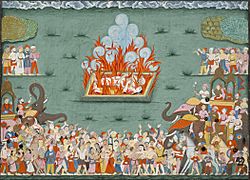Madhavrao I facts for kids
Quick facts for kids
Shrimant Peshwa
Madhavrao I
Ballal
|
|
|---|---|
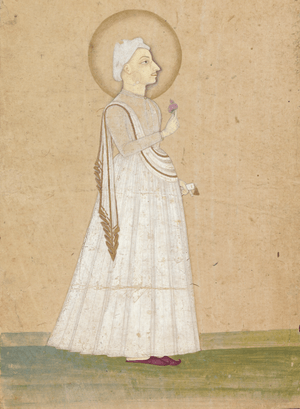
Portrait of Pradhanpant Shreemant Madhavrao Ballal Peshwa at the Yale Center for British Art
|
|
| 9th Peshwa of the Maratha Empire | |
| In office June 23, 1761 – November 18, 1772 |
|
| Monarch | Rajaram II of Satara |
| Preceded by | Balaji Baji Rao |
| Succeeded by | Narayan Rao |
| Personal details | |
| Born |
Madhavrao Bhat
February 15, 1745 Savanur, Savanur State, Maratha Confederacy (modern day Karnataka, India) |
| Died | November 18, 1772 (aged 27) Theur, Pune, Maratha Confederacy (modern day Pune district, Maharashtra, India) |
| Spouse |
Ramabai
(m. 1758) |
| Relations | Vishwasrao (Elder brother) Narayan Rao (Younger brother) |
| Parents | Balaji Bajirao (Father) Gopikabai (Mother) |
| Residences | Shaniwarwada, Pune, Maratha Confederacy |
| Signature | |
Madhavrao I (born February 15, 1745 – died November 18, 1772) was an important leader in Indian history. He became the 9th Peshwa of the Maratha Empire. A Peshwa was like a prime minister or chief minister in the Maratha kingdom. During his time, the Maratha Empire became strong again. This happened after they faced big losses in a major battle called the Third Battle of Panipat. People remember his rule as a time when the Maratha power grew back.
Contents
Becoming the Peshwa
Madhavrao Bhat was the second son of Peshwa Nanasaheb. His grandfather was the famous Bajirao I. Madhavrao was born in Savnur in 1745. When he was born, the Maratha Empire was very large. It covered a big part of Western, Central, and Northern India. In 1758, Madhavrao married Ramabai in Pune.
Madhavrao's father, Nanasaheb, had made the Maratha Empire even bigger. He also tried to make the government work better. However, the Marathas suffered a big defeat in the Third Battle of Panipat in 1761. Many Maratha soldiers died, including Nanasaheb's oldest son, Vishwasrao, and his cousin, Sadashivrao Bhau. Nanasaheb died soon after, on June 23, 1761.
After his father's death, Madhavrao was only sixteen years old. He was chosen to be the next Peshwa. His uncle, Raghunathrao, was supposed to help him rule as a regent.
Early Years as Leader
When Madhavrao became Peshwa, the Maratha Empire was in a difficult situation. The defeat at Panipat had left them with many debts. At Shaniwar Wada, the main home of the Peshwa, things were not very organized. Madhavrao noticed that the administration and treasury needed better management. He decided to take charge himself. He also made changes to improve discipline.
In 1762, the Peshwas went to fight in Karnataka. This was one of the first conflicts against the Nizam. During this time, Madhavrao and his uncle Raghunathrao had disagreements. Raghunathrao left the army and went back to Pune. Madhavrao continued the fight and later signed a peace treaty with the Nizam. Madhavrao and Raghunathrao often preferred different generals. Madhavrao liked Gopalrao Patwardhan and Nana Fadnavis. Raghunathrao preferred Sakharam Bapu.
Challenges with Raghunathrao
The disagreements between Madhavrao and Raghunathrao grew stronger. In August 1762, Raghunathrao started building his own army. His men began taking things from nearby villages. This made Madhavrao angry. He decided to fight his uncle in November 1762. However, Madhavrao did not want to fight his own family. He offered a peace treaty. Raghunathrao agreed and asked Madhavrao to move his troops back. Madhavrao did this, but Raghunathrao tricked him. Raghunathrao attacked when Madhavrao's army was not ready.
Madhavrao was defeated in the Battle of Alegaon. He surrendered to Raghunathrao. After this, Raghunathrao took control of many decisions. He also tried to become friends with the Nizam. But this was a bad idea, as the Nizam slowly started taking over Maratha areas. Madhavrao explained the danger to his uncle. In March 1763, the Peshwas, led by Madhavrao again, decided to attack the Nizam. After many months, they fought the Nizam's army in the Battle of Rakshasbhuvan. The Nizam's army lost badly and retreated.
Wars Against Hyder Ali
In January 1764, Madhavrao decided to fight Hyder Ali for the second time. His large army included skilled generals. Raghunathrao did not join him. This war lasted for almost a year in Karnataka. However, Hyder Ali managed to escape. Madhavrao asked Raghunathrao for help, but Raghunathrao signed a treaty with Hyder Ali instead. This disappointed Madhavrao. Raghunathrao did this because he was worried about Madhavrao's growing power.
In 1767, Madhavrao I led a third expedition against Hyder Ali. He defeated Hyder Ali in battles at Sira and Madhugiri. Madhavrao also found Queen Virammaji and her son. They were the last rulers of the Nayakas of Keladi Kingdom. Hyder Ali had kept them locked up in the fort of Madhugiri. Madhavrao I rescued them and sent them to Pune for safety.
Working with the Nizam
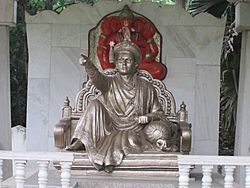
The Peshwas were expanding their control in northern India. Raghunathrao, along with other leaders, marched towards Delhi. Their goal was to expand the Maratha Empire there. Meanwhile, Madhavrao made a brave choice. He decided to form a friendship with his old rival, Nizam Ali Khan, Asaf Jah II. The Nizam also wanted to improve their relationship. They met in Kurumkhed in February 1766. Over the next few days, they shared ideas and concerns. Their understanding grew stronger, and their relationship became better.
Dealing with the East India Company
In December 1767, a British officer named Mastin came to Pune. Mastin worked for the East India Company. He wanted to set up military bases in the areas of Vasai and Sashthi. But Madhavrao was careful and did not trust his intentions. Mastin kept asking to get these areas. He offered to help defeat Hyder Ali in return. But Madhavrao never agreed to his requests.
Raghunathrao Under House Arrest
Even though Raghunathrao had gone north to expand the empire, he did not succeed. He came back and again tried to gather his generals to fight against Madhavrao. This time, Madhavrao was very upset with his uncle's repeated attempts to take over. On June 10, 1768, Madhavrao fought Raghunathrao. He captured him and placed him under house arrest at Shaniwar Wada. His assistant, Sakharam Bapu Bokil, was also arrested.
Attack on Madhavrao

On September 7, 1769, an incident happened. Madhavrao was returning from the Parvati temple in Pune with his friends. Suddenly, one of his generals, Ramsingh, attacked him with a sword. Madhavrao was warned just in time. He tried to dodge and was hit on his shoulder. Madhavrao believed that Raghunathrao had planned this attack. He put General Ramsingh in prison.
Madhavrao's Death
In June 1770, the Peshwas went to fight Hyder Ali for the third time. However, Madhavrao became sick with tuberculosis. This disease made his health worse. He had to return from Miraj because he was very ill. Doctors were consulted, but there was no cure for tuberculosis at that time. Madhavrao decided to spend his last days at his favorite Ganesha temple, the Chintamani Temple, Theur.
On October 6, 1772, Raghunathrao tried to escape from house arrest at Shaniwar Wada. But he was caught again. Madhavrao was very weak and could not handle such events anymore. He had built a garden and a fountain near his favorite temple.
Madhavrao died early in the morning on November 18, 1772, at the Chintamani temple in Theur. Thousands of people came to pay their last respects. Madhavrao was cremated on the banks of a river, about half a mile from the temple. A small stone memorial stands there today.
His wife, Ramabai, chose to perform sati (a historical practice where a widow would join her husband on his funeral pyre) with his body during the cremation.
Madhavrao's Character
Madhavrao was known for being a fair and caring leader. One day, he was busy managing the kingdom's money. He saw a large crowd waiting outside Shaniwar Wada. He learned that these were people from Pune who had lost their homes, land, and families in the war. They had been trying to meet him for days, but the guards had stopped them.
Madhavrao became very angry with the guards. He immediately stopped his work and went outside. He met with the families himself and listened patiently to each one. He wrote down what each family had lost. He made sure that they were paid back from the empire's money. This shows why people trusted and respected him so much.

Even though he had problems with his uncle Raghunathrao, Madhavrao still cared for him personally. Madhavrao even fined his own uncle, Rastemama, for allowing the Nizam's men to attack Pune. Rastemama complained to Madhavrao's mother, Gopikabai. Gopikabai asked Madhavrao to remove the fine, but he refused. He did not change his mind even when she threatened to leave Shaniwarwada. Gopikabai decided to live separately, but they still wrote letters to each other often. Madhavrao had great respect and love for his mother.
Madhavrao was a very skilled leader. He made big changes in the Maratha Empire. He made the government more efficient and honest. Officials who were lazy or corrupt were punished. This brought much-needed discipline to the administration. The justice system was fair and managed by Ram Shastri, who was known for his honesty. The money collected was used to help the citizens. The army's weapons were always updated, and the empire remained strong.
Madhavrao was respected by his servants, but he was also easy for common people to approach. He always remembered that he was not the king. He made sure others knew this too.
See also
- Mahadaji Pant Guruji
- Maratha Peshwa and Generals from Bhat Family
- Maratha emperors


